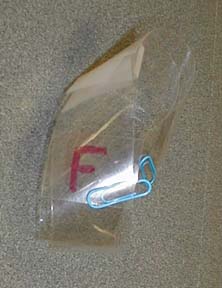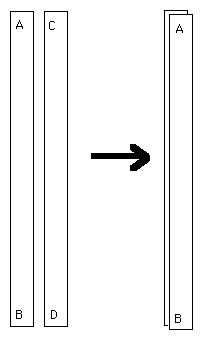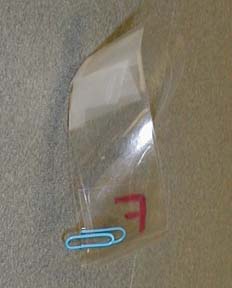
A letter F on a strip of acetate in a Mobius shaped
slot.

A letter F on a strip of acetate in a Mobius shaped
slot.
Introduction
When a right handed inhabitant of a Mobius Universe makes one trip around the universe it becomes left handed.
Material
Assembly
Make two identical strips of acetate and label the ends with letters as shown in the picture. Lay one strip on top of the other with end A on top of end C.

Take this double strip and bring the ends together to make a loop. Suppose you taped the ends of the strips together, attaching the A to B and C to D. You'd get two nested loops. Simple.
Don't tape them yet. Instead, put a half twist in the loop and bring A to D and B to C. Now tape the ends together so that you have a double layer Mobius strip.
Cut a square 2.5 cm on a side from the remaining
acetate.
Mark a capital F on this strip.
To Do and Notice
The space between these two pieces of transparency is pretty clearly a Mobius strip-shaped space. You can do a little experimenting with this space using your paperclip. Hold onto one end of the paper clip and stick the clip between the two strips. Now run the paperclip all the way around the loop, following the space between the strips. You can manage this easily enough. The paperclip has just followed a Mobius strip, encountering no obstacles along the way.
By the way, the mathematician's Mobius strip like the mathematician's plane has no thickness. Some people have trouble remembering this when they deal with Mobius strips made of paper, but they can visualize the the Mobius strip made of the empty space between the two bands getting thinner and thinner without limit.
Slide a paper clip handle onto the letter F acetate. so that the clip sticks out of the middle shorter bar of the F.
Slide the F acetate into the Mobius space made from the twisted acetate strips.
Now take the letter F for a journey around the Mobius space.
After one trip around it returns to the same position with a change. The letter F now points the other way. If the original letter F was right-facing the new one is left-facing.

Continue the journey for another lap around the Mobius space. the second time you return to the same spot the F has been returned to its original shape.
What's Going On?
After going around the Mobius space once notice that the paper clip is on the opposite side from which it started.
Note also that you are looking through the back of the F-acetate.
If you pull the F-acetate out from your sandwich and turn it over you will see that the right-facing F becomes a left-facing one when viewed from the other side.
So What?
It is said that the electron spins. However it seems that the electron has to spin through 720 degrees to go around once! This Mobius journey for the F is a model of this strange behavior of the electron.
Scientists wonder if there exists a three dimensional space such that if you travel completely around the space you return reversed right to left.
Etc
It seems obvious that you must have two Mobius
strips here.
Here comes the surprise. (You know there had to be one.) Try to
separate the two Mobius strips. Surprise! It isn't two Mobius strips
at all. It's one big loop with two full half twists. Once you
un-nest the strips, it isn't a Mobius strip at all.
How strange. It appeared that you had a Mobius strip. Now you don't. I think of the doubly twisted loop that you get when you un-nest the strips as the paint on a Mobius strip! That is exactly what it is. This doubly twisted loop formed the surface around a Mobius space. And, interestingly enough, the surface around a Mobius strip has two sides: the side that's up against the strip and the other side, the outside.
With an effort, you can make that big loop back into the nested Mobius loop. Give it a try.
This is a good example of a mathematical process known as a trapdoor cipher. One that it is easy to go one way through, to take apart, and harder to go the other way, to reassemble.
|
Scientific Explorations with Paul Doherty |
|
20 October 2000 |